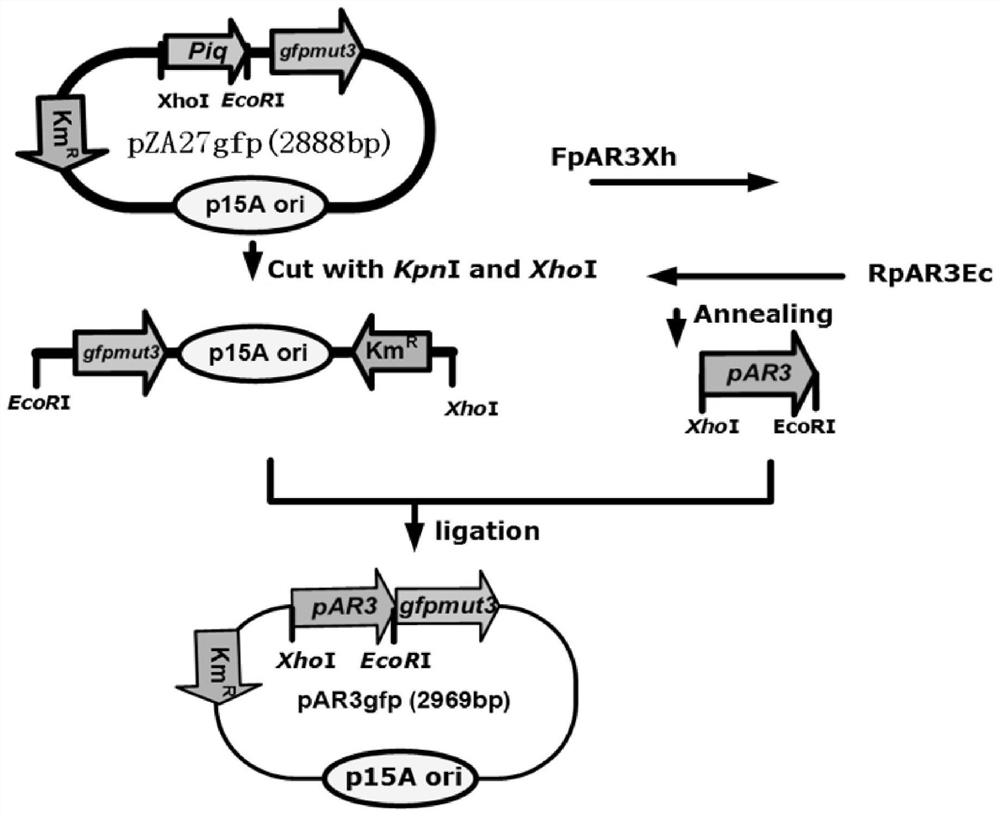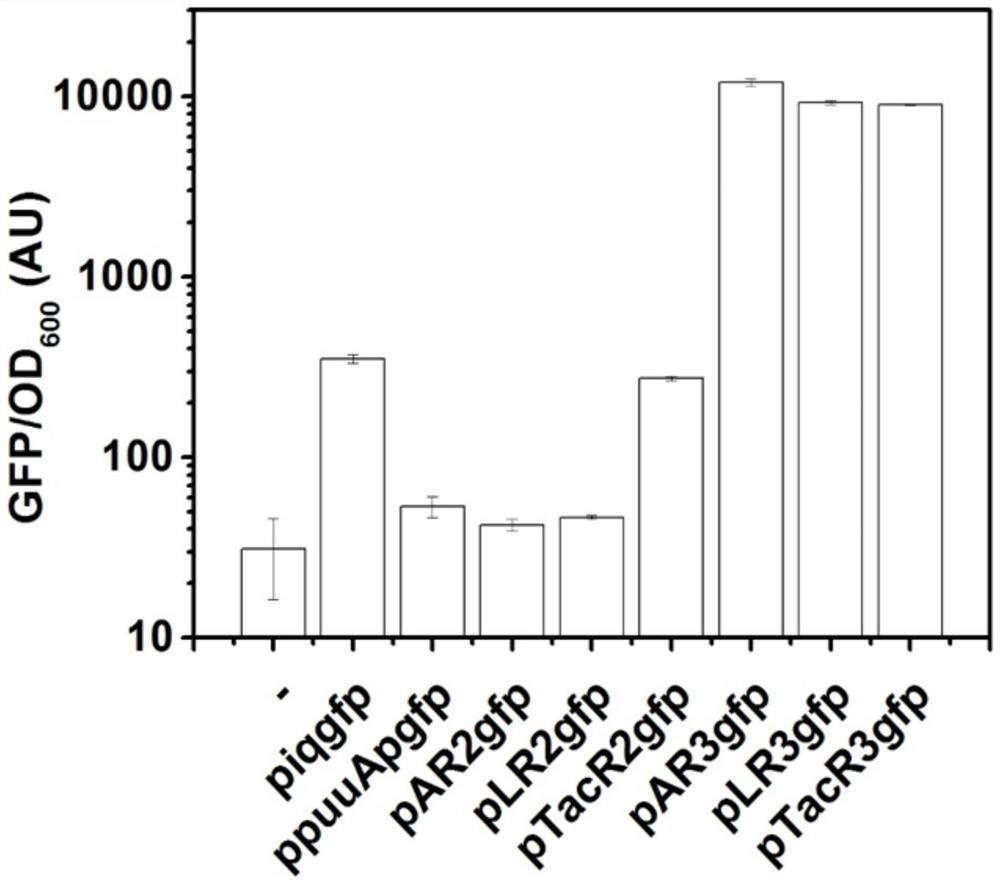A class of tunable putrescine bioluminescence sensor and its application
A fluorescent sensor, putrescine technology, applied in the fields of molecular biology and synthetic biology, can solve the problems of inability to monitor the dynamic process of metabolism in real time, slow analysis speed, and hidden health risks.
- Summary
- Abstract
- Description
- Claims
- Application Information
AI Technical Summary
Problems solved by technology
Method used
Image
Examples
Embodiment 1
[0054] In this example, the artificially designed promoter was constructed.
[0055] The specific operation of this example includes: two steps of direct denaturation and annealing of the two single-stranded nucleotides of the artificially designed promoter, and the construction of an artificially designed promoter fragment containing sticky ends of XhoI and EcoRI.
[0056] Single-stranded nucleotides are:
[0057] pLR2: single-stranded nucleotide 1 as shown in Seq ID No.11, namely:
[0058] 5'-TCGAGATAAATTATCTCTGGCGGTGTTGACAGTGGTCATTATATTTTACGCGATACTGAGCACAGTGGTCATTATATTTTACGCG-3'
[0059] Single-stranded nucleotide 2 is shown in Seq ID No.12, namely:
[0060] 5'-AATTCGCGTAAAATATAATGACCACTGTGCTCAGTATCGCGTAAAATATAATGACCACTGTCAACACCGCCAGAGATAATTTATC-3'
[0061] pAR2: single-stranded nucleotide 1 as shown in Seq ID No.13, namely:
[0062] 5'-TCGAGAAAATTTATCAAAAAGAGTGTTGACTGTGGTCATTATATTTTACGCGATACTTAGATTCAGTGGTCATTATATTTTACGCG-3'
[0063] Single-stranded nucleotide 2 is sho...
Embodiment 2
[0085] In this embodiment, a putrescine bioluminescence sensor is built through the following operations:
[0086] 1) Mix the artificially designed promoter fragment containing sticky ends after digestion with XhoI and EcoRI in Example 1 with the linear fragment of plasmid pZA27gfp after digestion with XhoI and EcoRI at 37° C. for 4 hours, and then in T4 ligase Under the action, connect overnight at 16°C, and transfer into Escherichia coli Top10 competent cells. In order to construct the correct pLR2gfp, pAR2gfp, pLR3gfp, pAR3gfp, pTacR2gfp, pTacR3gfp plasmids, spread the transformants on the card containing a final concentration of 50 μg / mL On the LB solid plate of namycin, after culturing overnight at 37°C, pick positive single clones and inoculate them into LB medium, at 37°C, 220rpm, 12-14 hours, and extract the plasmid for sequencing.
[0087] 2) Transform the correct pLR2gfp, pAR2gfp, pLR3gfp, pAR3gfp, pTacR2gfp, pTacR3gfp plasmids into Escherichia coli MG1655, spread on...
Embodiment 3
[0092] In this implementation, putrescine biosensors with different PuuR expression levels were established through the following operations:
[0093] 1) Using MG1655 genomic DNA as a template, PCR was performed with primer sequence numbers: 23 and 24, and the puuR gene containing KpnI and XmaI restriction sites was amplified, and then ligated with the linearized vector pZA27gfp after double digestion to construct the The correct pZA27puuR plasmid.
[0094] Seq ID NO.23: 5'-CGG GGTACC ATGAGTGATGAGGGACTGGC-3'
[0095] Seq ID NO.24: 5'-TCCC CCCGGG TTAAAACGTGGTGGGCGTAT-3'
[0096] The reaction system is: template 1 μL, primers 1 and 2 each 1 μL, DMSO 5 μL, 2×Primer Max mix 25 μL, sterilized water 17 μL;
[0097] The reaction conditions are: denaturation at 98°C for 5min; denaturation at 98°C for 30s; annealing at 58°C for 30s; extension at 72°C for 1min; 30cycles; 5min at 72°C; 10min at 12°C;
[0098] 2) Using the pZA27puuR plasmid as a template and primer sequence numbers...
PUM
 Login to View More
Login to View More Abstract
Description
Claims
Application Information
 Login to View More
Login to View More - R&D
- Intellectual Property
- Life Sciences
- Materials
- Tech Scout
- Unparalleled Data Quality
- Higher Quality Content
- 60% Fewer Hallucinations
Browse by: Latest US Patents, China's latest patents, Technical Efficacy Thesaurus, Application Domain, Technology Topic, Popular Technical Reports.
© 2025 PatSnap. All rights reserved.Legal|Privacy policy|Modern Slavery Act Transparency Statement|Sitemap|About US| Contact US: help@patsnap.com



